Accepted Scientific Name: Euphorbia celastroides Boiss.
Prodr. [A. P. de Candolle] 15(2): 11 (1862) DC. et al.

Euphorbia celastroides var. laehiensis Photo by: Forest Starr & Kim Starr
Habit at Manawainui, Hawaii (USA), Maui.
Origin and Habitat: Euphorbia celastroidesSN|28904]]SN|28904]] var. laehiensis is one of the recognised varieties of a widespread and variable species that grows at low elevations on arid talus slopes, at Lana'i and East Maui near Manawainui, in the island of Maui, Hawaii (USA). It is rare and endangered.
Habitat and ecology: It is found at low elevations and endangered.
Synonyms:
See all synonyms of Euphorbia celastroides
back
Accepted name in llifle Database:Euphorbia celastroides Boiss.Prodr. [A. P. de Candolle] 15(2): 11 (1862)Synonymy: 49
back
Common Names include:
HAWAIIAN (ʻŌlelo Hawaiʻi): Akoko, Ekoko, Koko, Kokomalei
Description: The ʻakoko Euphorbia celastroidesSN|28904]]SN|28904]] var. laehiensis, previously also known as Chamaesyce celastroidesSN|28905]]SN|28905]] var. laehiensis, is one of the several varieties of the spurge Euphorbia celastroidesSN|28904]]SN|28904]] distinguished by its glaucous (opaque bluish) pubescent (fuzzy) leaves. The variety laehiensis is a evergreen sprawling shrub and can have a spread of 2 metres or more. While the flowers are not showy, the bright pinkish to red fruits can be uniquely appealing en masse.
Stems: It forms a loosely branching short trunk. The secondary or young branches are stiff, with short internodes. A milky, sticky latex naturally oozes from wounds.
Leaves: Distichous (growing in two vertical rows), up to 15 mm long, grey-silverish, pubescent and have an opaque glaucous coating. Often the leaves in the summer assume a red-violet colouring. It does not lose its leaves in the winter, due to the warm climate of its range. Damaged or old leaves turn a blood red as they die.
Flowers (cyathia): Small, brownish to greenish-white, not showy, a few millimeters in diameter, located in short or open-branched cymes, or ungrouped in leaf axils. Female cyathia have a three-part pistil over a three-part ovary, usually producing three (or sometimes more) seeds. The pungent flowers of ʻakoko have been described as smelling like bad breath.
Fruit: Green or reddish-brown or pink, rounded 2 to 4 mm long. Within each capsule are two or three small seeds.
Phenology: Euphorbia celastroidesSN|28904]]SN|28904]] var. laehiensis produces flower and fruit sporadically throughout the year.
Seeds: Grey-brown seeds 0.5 to 2.5 mm long.
Subspecies, varieties, forms and cultivars of plants belonging to the Euphorbia celastroides group
 Euphorbia celastroides Boiss.: (var. celastroides) Leaves narrowly obovate glabrous (without hairs). Distribution: endemic to Nihoa, Ni`ihau, Kaua`i.
Euphorbia celastroides Boiss.: (var. celastroides) Leaves narrowly obovate glabrous (without hairs). Distribution: endemic to Nihoa, Ni`ihau, Kaua`i. Euphorbia celastroides var. amplectens Sherff: Has pubescent (with hairs) leaves, grey/silverish to light green that may have a glaucous coating. Distribution: is a variable plant found on the uplands on all the main islands (Ni`ihau, Kaua`i, O`ahu, Moloka`i, Lana`i, Maui, Kaho`olawe, Hawai`i.)
Euphorbia celastroides var. amplectens Sherff: Has pubescent (with hairs) leaves, grey/silverish to light green that may have a glaucous coating. Distribution: is a variable plant found on the uplands on all the main islands (Ni`ihau, Kaua`i, O`ahu, Moloka`i, Lana`i, Maui, Kaho`olawe, Hawai`i.)- Euphorbia celastroides var. hanapepensis Sherff: has glabrous, long and oblanceolate leaves. Distribution: endemic to Kaua`i where it grows at high elevations.
- Euphorbia celastroides var. kaenana Sherff: is a glabrous beach plant, with flowers (cyathia) on compact lateral branches. Distribution: endemic to to Kaʻena, Oʻahu. It is a rare and endangered beach plant found among the boulders.
 Euphorbia celastroides var. laehiensis O.Deg., I.Deg. & Sherff: Habit pubescent. Leaves glaucous. Distribution: endemic to Lana`i, Maui near Manawainui. It is found at low elevations and endangered.
Euphorbia celastroides var. laehiensis O.Deg., I.Deg. & Sherff: Habit pubescent. Leaves glaucous. Distribution: endemic to Lana`i, Maui near Manawainui. It is found at low elevations and endangered. Euphorbia celastroides var. lorifolia (A.Gray ex H.Mann) Sherff: is a rare, small and vulnerable tree, with pubescent linear leaves found at high elevations. Distribution: endemic to Lana`i, Maui.
Euphorbia celastroides var. lorifolia (A.Gray ex H.Mann) Sherff: is a rare, small and vulnerable tree, with pubescent linear leaves found at high elevations. Distribution: endemic to Lana`i, Maui.  Euphorbia celastroides var. stokesii (C.N.Forbes) Sherff: is a beach plant, glabrous. Leaves broadly obovate. Distribution: endemic to Ni`ihau, Kaua`i, Moloka`i, Kaho`olawe.
Euphorbia celastroides var. stokesii (C.N.Forbes) Sherff: is a beach plant, glabrous. Leaves broadly obovate. Distribution: endemic to Ni`ihau, Kaua`i, Moloka`i, Kaho`olawe.- Euphorbia celastroides var. tomentella (Boiss.) Oudejans: Tomentose. Distribution: Endemic to Waiʻanae Mts., O`ahu and presumed extinct.
Bibliography: Major references and further lectures
1) Forest & Kim Starr “Euphorbia celastroides var. laehiensis (Akoko)”. Plants of Hawaii. <http://www.starrenvironmental.com>. Web. 27 Sep. 2014.
2) Wikipedia contributors. "Euphorbia celastroides." Wikipedia, The Free Encyclopedia. Wikipedia, The Free Encyclopedia, 14 May. 2014. Web. 27 Sep. 2014.
3) Wagner, W.; D. Herbst; S. Sohmer “Manual of the flowering plants of Hawaii.” Honolulu: University of Hawaii Press 1990
4) National Museum of Natural History “Flora of the Hawaiian Islands” <http://botany.si.edu/pacificislandbiodiversity/hawaiianflora/> Smithsonian Institution Web. 27 Sep. 20149
5) Andrew W. Mitchell “The Fragile South Pacific: An Ecological Odyssey” University of Texas Press, 1990
6)Geological and Natural History Survey of Minnesota “Reports of the Survey" Geological and Natural History Survey of Minnesota: Botanical series, Volume 2, 1898
7) John L. Culliney, Bruce P. Koebele “A Native Hawaiian Garden: How to Grow and Care for Island Plants” University of Hawaii Press, 1999
8) Warren Lambert Wagner, Derral R. Herbst, S. H. Sohmer “Manual of the Flowering Plants of Hawaii” Volume 1 University of Hawaii Press, 1990
9) National Museum of Natural History “Flora of the Hawaiian Islands” <http://botany.si.edu/pacificislandbiodiversity/hawaiianflora/> Smithsonian Institution Web. 27 Sep. 2014.
10) Koutnik and Huft 4. “Chamaesyce.” In “Manual of the Flowering Plants of Hawaii” Warren L. Wagner, D.R. Herbst, S.H. Sohmer, eds., University of Hawaii Press and BishopMuseum Press, Honolulu. Pp. 602-617. 1990
11) Native Plants Hawaii. “Euphorbia celastroides var. laehiensis” <http://www.nativeplants.hawaii.edu> Web. 27 Sep. 2014
12) Beatrice Krauss "Plants in Hawaiian Culture" Univ of Hawaii Pr August 4, 2001
13) Marie C. Neal "In Gardens of Hawaii" by June 1, 1965
14) World Conservation Monitoring Centre 1998. Euphorbia celastroides var. laehiensis. The IUCN Red List of Threatened Species. Version 2014.2. <www.iucnredlist.org>. Downloaded on 28 September 2014.
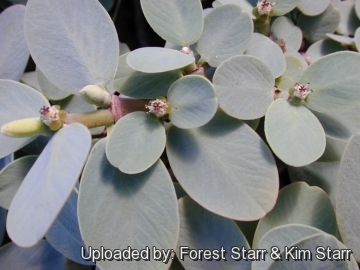 Flowers at Manawainui, Maui, Hawaii (USA). May 30, 2002. Photo by: Forest Starr & Kim Starr
Flowers at Manawainui, Maui, Hawaii (USA). May 30, 2002. Photo by: Forest Starr & Kim Starr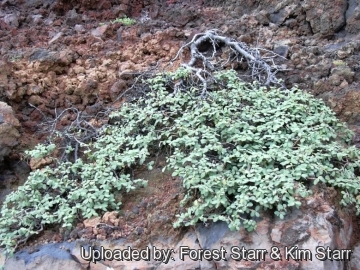 Habit at Manawainui, Hawaii (USA), Maui.May 14, 2004. Photo by: Forest Starr & Kim Starr
Habit at Manawainui, Hawaii (USA), Maui.May 14, 2004. Photo by: Forest Starr & Kim Starr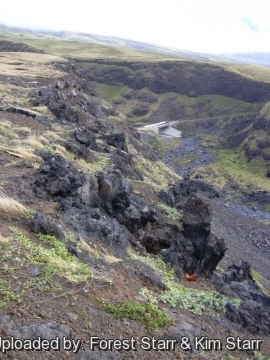 View mauka at Manawainui, Maui, Hawaii (USA). April 23, 2004. Photo by: Forest Starr & Kim Starr
View mauka at Manawainui, Maui, Hawaii (USA). April 23, 2004. Photo by: Forest Starr & Kim Starr Habit at backside Manawainui, Hawaii (USA), Maui. June 06, 2012. Photo by: Forest Starr & Kim Starr
Habit at backside Manawainui, Hawaii (USA), Maui. June 06, 2012. Photo by: Forest Starr & Kim Starr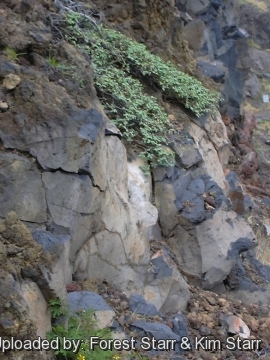 Habit at Manawainui, Hawaii (USA), Maui. May 14, 2004. Photo by: Forest Starr & Kim Starr
Habit at Manawainui, Hawaii (USA), Maui. May 14, 2004. Photo by: Forest Starr & Kim Starr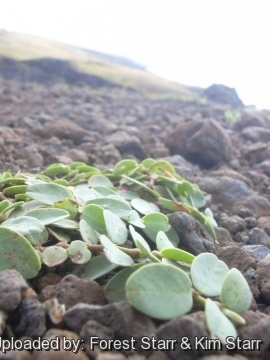 Habit at Manawainui, Hawaii (USA), Maui. April 23, 2004. Photo by: Forest Starr & Kim Starr
Habit at Manawainui, Hawaii (USA), Maui. April 23, 2004. Photo by: Forest Starr & Kim Starr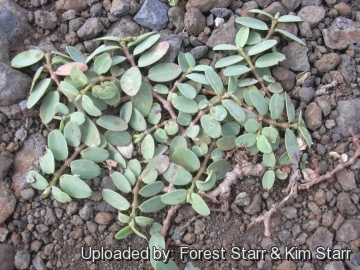 Habit at Manawainui, Hawaii (USA), Maui. Photo by: Forest Starr & Kim Starr
Habit at Manawainui, Hawaii (USA), Maui. Photo by: Forest Starr & Kim StarrSend a photo of this plant.The gallery now contains thousands of pictures, however it is possible to do even more. We are, of course, seeking photos of species not yet shown in the gallery but not only that, we are also looking for better pictures than those already present.
Read More... Cultivation and Propagation: Euphorbia celastroidesSN|28904]]SN|28904]] var. laehiensis or akoko is an attractive tropical species that requires temperatures of 15 °C and full sun to light shade. This plant develops in a fashion similar to a sprawling shrub and is tolerant of heat and drought.
Growth rate: They can grow to half a meter a year and flowering and fruiting in optimal conditions.
Potting medium: A gritty, very free-draining compost is suitable, and clay pots help the plants to dry out between watering. Re-pot every 2-3 years.
Fertilization: Akoko respond well to liquid fertilizer (once every one to two months).
Waterings: They like only a short winter's rest and should be kept almost completely dry during the winter months. If the soil is allowed to be dry for too long root loss could follow but equally the same result would occur if the plants are both wet and cold. From March onwards the plant will begin to grow and watering should be increased gradually until late May when the plant should be in full growth. Water regularly during the summer so long as the plant pot is allowed to drain and not sit in a tray of water. During hot weather you may need to water the plants more frequently so long as the plant is actively growing. From late September watering should be reduced to force the plant to go in to a state of semi dormancy, by October you should be back in to the winter watering regime.
Pruning: Generally not necessary to prune plants except to remove dead branches and leaves for a cleaner appearance in the landscape. However this species do tend to get sort of leggy, which is particularly a problem if grown as a potted plant, and pruning is sometime necessary to shape. Repeatedly prunings also help to encourage new growth. A milky, sticky latex naturally oozes from wounds.
Hawaiian Uses: The milky sap was one ingredient of the paint used on canoe hulls.
Pest and diseases: They are susceptible to fungal diseases. Wet soil quickly causes root and stem rot, especially during winter months. Pests of akoko include whitefly, scale insects, and mealybugs. Often the scale in-sects and mealybugs are brought in and protected by ants. Spider mites can also can damage to leaves.
Propagation: Seeds or cuttings. It is best to collect seed just before or just after the capsules split open to be sure to have fresh but mature seeds. Because of the small size of the seedlings, place little or no cover over the seedbed. Take extra care to avoid letting the seedbed dry out. The seeds will begin sprouting in one to two weeks (sometimes take longer). Let the seedlings grow to about 5 cm in height before separating and transplanting to individual containers. You can also propagate Euphorbia celastroidesSN|28904]]SN|28904]] by stem tip cuttings. Take cuttings about 10 cm in length from actively growing tips with mostly green wood. Rooting time is variableas long as two to three months. After root growth and new stem growth are obvious, transfer the new plant to a standard potting mix.

















